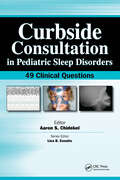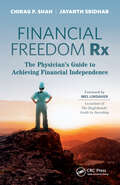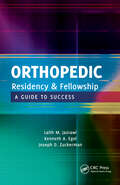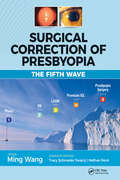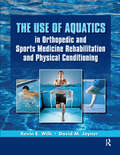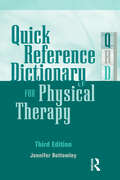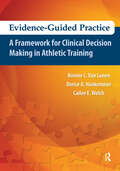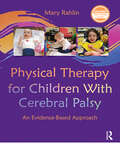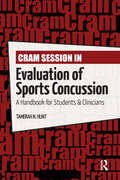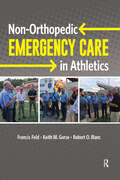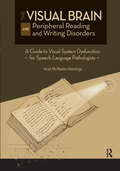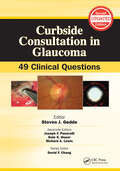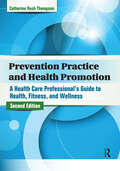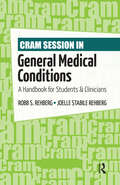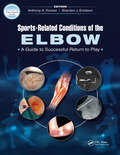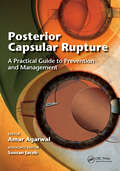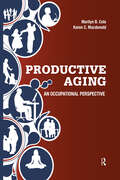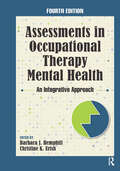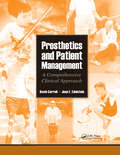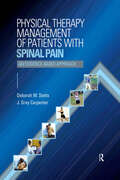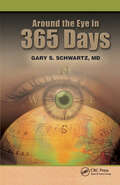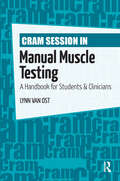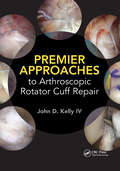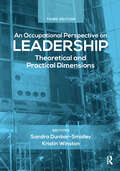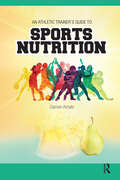- Table View
- List View
Curbside Consultation in Pediatric Sleep Disorders: 49 Clinical Questions (Curbside Consultation in Pediatrics)
by Aaron ChidekelAre you looking for concise, practical answers to those questions that are often left unanswered by traditional pediatric sleep disorder references? Are you seeking brief, evidence-based advice for complicated cases or controversial decisions? Curbside Consultation in Pediatric Sleep Disorders: 49 Clinical Questions provides quick answers to the tricky questions most commonly posed during a “curbside consultation” between pediatricians. Dr. Aaron Chidekel has designed this unique reference which offers expert advice, preferences, and opinions on tough clinical questions commonly associated with pediatric sleep disorders. The unique Q&A format provides quick access to current information related to pediatric sleep disorders with the simplicity of a conversation between two colleagues. Numerous images, diagrams, and references allow readers to browse large amounts of information in an expedited fashion.Some of the questions that are answered: Why do we sleep and what is happening when children sleep? How does sleep change from infancy to adulthood? What are the latest recommendations for safe infant sleep and the prevention of SIDS? What are some pearls or strategies to manage or even better, to prevent behavioral sleep disorders in young children? What is obstructive sleep apnea syndrome? What is narcolepsy and do children actually develop this condition? Which of my patients should have a polysomnogram? Curbside Consultation in Pediatric Sleep Disorders: 49 Clinical Questions provides information basic enough for residents while also incorporating expert advice that even high-volume pediatricians will appreciate. Pediatricians, family practitioners, and pediatric residents will benefit from the user-friendly, casual format and the expert advice contained within.
Financial Freedom Rx: The Physician’s Guide to Achieving Financial Independence
by Chirag Shah Jayanth Sridhar"The best physician-specific general financial book published in 2021." —James M. Dahle, MD, author of The White Coat InvestorA step-by-step guidebook for doctors and other medical professionals about growing and preserving wealth, Financial Freedom Rx: The Physician’s Guide to Achieving Financial Independence gives physicians all the tools necessary to manage their own finances and includes a foreword by Mel Lindauer, co-author of The Bogleheads' Guide to Investing. Medical professionals, especially doctors, spend many years in training as they accumulate debt and delay their earnings. This book presents a time-tested formula that students and established professionals can follow at any stage during their careers to achieve fiscal peace of mind. Students will learn how to budget and adopt disciplined financial practices. Residents and other trainees will learn how to defend against calamity with various insurances and how to manage debt. Junior professionals will acquire the skills needed to invest and grow their portfolios, while senior professionals will better understand the essentials of estate planning and retirement. Drs. Chirag P. Shah and Jayanth Sridhar wrote this inspiring text to guide physicians where to put their next dollar. This is particularly important during the financial uncertainties brought on by COVID-19 and insurance cuts. Financial Freedom Rx sets forth principles that will pilot medical professionals toward financial independence. Chapters include useful advice on topics such as: Financial planning Investing and asset allocation Jobs and contracts Taxes and insurance Student loans and debt Retirement savings and distributions Financial Freedom Rx: The Physician’s Guide to Achieving Financial Independence serves as a timeless blueprint for financial planning that medical professionals will follow throughout their careers, and as a reference that readers will revisit again and again as they progress through the various stages of life.
Orthopedic Residency and Fellowship: A Guide to Success
by Kenneth Egol Joseph Zuckerman Laith JazrawiOrthopedic surgery remains one of the most competitive subspecialties in medicine. This “how- to” guide describes how medical students can achieve their goal of being accepted into an orthopedic residency program and how to thrive once there.What will you learn from Orthopedic Residency and Fellowship: A Guide to Success?• How medical students can achieve their goal of being accepted into an orthopedic residency program• How to succeed during and after your residency• Tips and pearls to maximize your experience• Budgeting your time• Peer interaction• Job placement• How to read a contract• How to decide between academic or private practice• Asset protection • Making the right financial decisionOrthopedic Residency and Fellowship: A Guide to Success by Drs. Laith M. Jazrawi, Kenneth A. Egol and Joseph D. Zuckerman is the only book on the market that solely focuses on getting into an orthopedic residency or fellowship training program, excelling once you are there, and maximizing and obtaining the right practice opportunity for you. Providing easy-to-read chapters and quick reference materials, this book is a must-read for anyone interested in the field of musculoskeletal care.
Surgical Correction of Presbyopia: The Fifth Wave
by Ming WangUntil recently, surgical correction of presbyopia was considered the “last frontier” in ophthalmology, but today there are a wide variety of treatments available. This Fifth Wave of ophthalmology opens up a whole world of surgical solutions for presbyopes who would otherwise have no recourse, and Surgical Correction of Presbyopia: The Fifth Wave is designed as a complete guide to the wide range of surgical solutions available. Dr. Ming Wang is joined by Associate Editors Drs. Tracy Schroeder Swartz and Nathan Rock and their all-star team of expert contributors to compile the first comprehensive review of all the state-of-the-art surgical treatments for presbyopia. This includes a history of refractive and lens surgery, a review of presbyopia and its medical management, as well as in-depth sections on not only those surgical treatments that are currently available but also those under active clinical investigation. Inside Surgical Correction of Presbyopiais a detailed presentation on corneal solutions, including laser treatments and corneal inlays; lenticular solutions, including intraocular lenses; and scleral solutions, such as scleral implants and ablation. Each procedure features a discussion on the indications, benefits, results and risks of the procedure with close attention to clinical applications. Also included are chapters on complex cases, which focus on improving outcomes both with patient and surgical modality selection and postoperative management.Chapters include: Excimer and Femtosecond LASER for Treatment of Presbyopia Shape-Changing Inlays Multifocal Intraocular Lenses Extended Depth of Focus Intraocular Lenses Laser Scleral Microablation Procedure Marketing Surgical Treatment for Presbyopia The Future of Presbyopia Treatment Presbyopia is the most common refractive condition and more patients and providers are actively seeking surgical solutions. With Surgical Correction of Presbyopia: The Fifth Wave, anyone from ophthalmology technicians and opticians to practicing ophthalmologists and optometrists will confidently understand and be prepared to tackle this “last frontier” of ophthalmology.
The Use of Aquatics in Orthopedics and Sports Medicine Rehabilitation and Physical Conditioning
by David Joyner Kevin WilkThe Use of Aquatics in Orthopedic and Sports Medicine Rehabilitation and Physical Conditioning is a definitive and scientifically based text on the use and application of aquatic methodologies in both rehabilitation and physical conditioning appropriate for the general population to the elite athlete.The Use of Aquatics in Orthopedic and Sports Medicine Rehabilitation and Physical Conditioning represents a new generation of rehabilitation that is informative enough to be injury and sports specific. Dr. Kevin E. Wilk and Dr. David M. Joyner, along with noted domestic and international leaders in the field, explore the aquatic techniques and principles detailed in the work, while presenting this scientifically based material in an understandable and user-friendly format. Ten chapters take the reader from the history of aquatic rehabilitation and progress to discuss all parameters of aquatic rehabilitation.Some chapter topics include:• History, theory, and applications of aquatic therapy• Pool selection, facility design, and engineering considerations• Rehabilitation for the upper and lower extremities and spine• Sports-specific training• Research evidence for the benefits of aquatic exercise• Appendices, including 4 specific protocols for various lesions and disordersThe Use of Aquatics in Orthopedic and Sports Medicine Rehabilitation and Physical Conditioning represents a new era in the use and development of aquatic therapy in sports medicine rehabilitation and is perfect for physical therapists, athletic trainers, strength and conditioning coaches, personal trainers, and sports medicine professionals alike.
Quick Reference Dictionary for Physical Therapy
by Jennifer BottomleyQuick Reference Dictionary for Physical Therapy has been revised and updated into a Third Edition to include the latest information in the field of physical therapy. This reference book, designed specifically for the physical therapy and physical therapist assistant student and practitioner, provides a magnitude of terms, definitions, guidelines, and references essential to the field. This Third Edition provides quick access to over 3400 words and their definitions that are encountered on a day-to-day basis (400 more than the previous edition). There are also 41 appendices in this user-friendly, pocket-sized reference where you can find information such as lists of general acronyms and abbreviations for words commonly used in physical therapy/rehabilitation; commonly used acronyms for evaluative tests and measures; and definitions of impairment, disability, and handicap as established and accepted by the World Health Organization. What is new inside the Third Edition:• More than 100 new abbreviations and acronyms• Updated Code of Ethics for the Physical Therapist• A new Drug Prescribing and Elimination Abbreviations appendix• Updates to suggested readingsQuick Reference Dictionary for Physical Therapy, Third Edition is the perfect, pocket size, affordable companion for school, clinical affiliations, and physical therapy practice.
Evidence-Guided Practice: A Framework for Clinical Decision Making in Athletic Training
by Bonnie Van Lunen Dorice Hankemeier Cailee WelchAthletic trainers must have a foundation in the concepts of evidence-based practice to deliver patient care in an effective way. It is critical that students and clinicians formulate clinical plans that will be effective for individual patients. With that goal in mind, Evidence-Guided Practice: A Framework for Clinical Decision Making in Athletic Training teaches the athletic trainer that evidence-based practice concepts must be incorporated into daily clinical practice. Written in a conversational tone, Drs. Bonnie Van Lunen, Dorice Hankemeier, and Cailee Welch provide a practical and concise resource for athletic trainers to use when interpreting what the available evidence means for them and how it can be effectively applied in daily patient care. The competencies within athletic training and other health care professions were considered when each chapter was constructed. Special care was taken to include examples that are specific to athletic training and instructional applications for educators.What Is Inside: Types of research design Foundations of research and statistics Introduction to critical appraisal Concepts of validity Diagnostic accuracy Disablement models Patient-oriented outcome assessments Health care informatics The first of its kind, Evidence-Guided Practice: A Framework for Clinical Decision Making in Athletic Training is the only resource athletic training students, clinicians, or other health care professionals will need to properly put evidence-based concepts into practice.
Physical Therapy for Children With Cerebral Palsy: An Evidence-Based Approach
by Mary RahlinCerebral palsy is the most common movement disorder encountered in pediatric physical therapy practice. Physical Therapy for Children With Cerebral Palsy: An Evidence-Based Approach is a unique, comprehensive reference that focuses on physical therapy management of children with cerebral palsy through the analysis and synthesis of published research, and it offers evidence-based teaching and learning opportunities to a wide reading audience.Inside, Dr. Mary Rahlin examines the current approach to the diagnosis and classification of cerebral palsy and explores the research evidence related to prognosis; medical management; and physical therapy examination, evaluation, and intervention for children with this condition. Physical Therapy for Children With Cerebral Palsy analyzes cerebral palsy as a lifespan condition and utilizes the framework of International Classification of Functioning, Disability and Health (ICF).Sections include: Typical and atypical development of movement and postural control Cerebral palsy as a development disorder Medical management of alterations of body structures and functions by body systems Physical therapy management, including theoretical foundation, research evidence, and practice Normal and abnormal gait patterns and current evidence for orthotic management and assistive technology Transition to adult life Unique topics discussed: Variability, complexity, and adaptability in motor development The interdisciplinary team and effective interprofessional collaboration Assessment and management of therapy-related behavior Complementary and alternative interventions Segmental kinematic approach to orthotic management via ankle-foot-orthosis/footwear combination Other unique features include “Questions to Ponder” and “Suggested Questions for Future Research” at the end of each chapter. These are intended to generate healthy professional debate on a variety of topics, both in the classroom and in the clinic, and challenge the readers to plan new studies in search for evidence that will continue moving the pediatric physical therapy practice forward. Bonus! Also included with Physical Therapy for Children With Cerebral Palsy is online access to video clips that accompany the text and highlight typical and atypical development, use of assistive technology, life span issues, and transition to adulthood.Physical Therapy for Children With Cerebral Palsy: An Evidence-Based Approach is intended for physical therapy students, educators, residents, and experienced clinicians, including physical therapists, other members of the interdisciplinary team, and researchers working with children with cerebral palsy.
Cram Session in Evaluation of Sports Concussion: A Handbook for Students & Clinicians
by Tamerah HuntWhen you need a fundamental and clinical understanding of sports concussions, supplemented by current research and management techniques, look to Cram Session in Evaluation of Sports Concussion: A Handbook for Students & Clinicians for quick and at-your-fingertips facts.Cram Session in Evaluation of Sports Concussion: A Handbook for Students & Clinicians by Dr. Tamerah N. Hunt is a succinct and descriptive quick reference that provides the health care professional with a simple step-by-step approach to various sports concussion assessment and management techniques. Cram Session in Evaluation of Sports Concussion: A Handbook for Students & Clinicians is designed to bridge the gap between research and clinical practice to improve assessment and management of sports-related concussion and return-to-play decisions. What is in your “Cram Session”: • Concept maps• Red flags for differential diagnoses• Return to participation guidelines• Detailed algorithms for evaluation, testing, and working with other health care professionals• Model protocols and management strategies that can be implemented with minimal resources and support staffCram Session in Evaluation of Sports Concussion: A Handbook for Students & Clinicians is an informative, well-organized handbook for all students and clinicians in athletic training, physical therapy, and allied health professionals who evaluate and manage concussions.
Non-orthopedic Emergency Care in Athletics
by Francis Feld Keith Gorse Robert BlancNon-Orthopedic Emergency Care in Athletics is a textbook that will help instruct athletic training students, certified athletic trainers, and other health care providers about the emergency medical situations they can potentially face throughout their careers. Francis Feld, Keith M. Gorse, and Robert O. Blanc, along with their contributors, have covered the most crucial types of serious medical emergencies that may be encountered in sports. Also included is material for each of the Domains listed in the NATA Board of Certification (BOC) and the Education Competencies and Proficiencies listed in the 2020 CAATE Standards. What is covered inside Non-Orthopedic Emergency Care in Athletics: Design and Implementation of Emergency Action Plans & Standard Operating Procedures Mass Casualty Substance Abuse Cardiac and Respiratory Care Endocrine Emergencies Environmental Conditions Shock Seizures Abdominal Emergencies Psychiatric Issues Bleeding Disorders Non-Orthopedic Emergency Care in Athletics is an ideal text for certified athletic trainers, athletic training students, and other health care providers focusing on the skills, knowledge, practice, and preparation needed to handle real athletic emergency medical situations.
The Visual Brain and Peripheral Reading and Writing Disorders: A Guide to Visual System Dysfunction for Speech-Language Pathologists
by Heidi HeeringaThe Visual Brain and Peripheral Reading and Writing Disorders: A Guide to Visual System Dysfunction for Speech-Language Pathologists familiarizes the reader with the complex workings of the human visual system, the motor and sensory components of normal vision as they relate to the recognition of letters and words, and to the acquisition and rehabilitation of reading and writing.This text brings together findings from the neuropsychological, neurooptometric, neurolinguistic, occupational therapy, and speech-language pathology literature on acquired visual system impairment from the past 20+ years, and the ways visual system dysfunction impacts reading, writing, and cognition.Chapters Include: Review of structural elements of the eye, the cortical and subcortical structures of the visual brain, and the motor and sensory components of normal vision The distinct functions of the three primary visual pathways (central, peripheral and retinotectal) and how they relate to reading and writing Review of five formal tests of reading and writing that are designed or may be adapted to assess peripheral reading and writing disorders And much more! A few of the features inside: Figures illustrating the various components of the visual brain that are engaged when we read and write Information on visual system deficits in left hemisphere lesions with and without aphasia Detailed descriptions of peripheral reading disorders and associated error patterns Diagnostic criteria for three different types of neglect (viewer-centered, stimulus-centered, object-centered) Description of treatment materials and methods suited to clients with acquired dyslexia due to visual system dysfunction The Visual Brain and Peripheral Reading and Writing Disorders explains the heterogenous nature of peripheral reading and writing disorders, describes the association between visual motor and sensory dysfunction and the acquired dyslexias, and provides the speech-language pathologist with specific guidelines regarding the assessment and treatment of reading and writing disorders associated with visual system dysfunction.
Curbside Consultation in Glaucoma: 49 Clinical Questions (Curbside Consultation in Ophthalmology)
by Steven GeddeCurbside Consultation in Glaucoma: 49 Clinical Questions has been updated into a Second Edition! The Second Edition contains new questions and is completely updated! Curbside Consultation in Glaucoma, Second Edition contains new questions and brief, practical, evidence-based answers to the most frequently asked questions that are posed during a “curbside consultation” between surgical colleagues. Dr. Steven J. Gedde and associate editors Dr. Dale K. Heuer, Dr. Richard A. Lewis, and Dr. Joseph Panarelli have assembled the top glaucoma consultants from the United States and abroad to offer expert advice, preferences, and opinions on tough clinical questions commonly associated with glaucoma in this updated reference. The unique Q&A format provides quick access to current information related to glaucoma in the simplicity of a conversation between two colleagues. Numerous images, diagrams, and references are included to enhance the text and illustrate surgical pearls. Some of the questions that are answered inside theSecond Editioninclude: - What imaging technology is best for diagnosing glaucoma? For detecting progression? - What new methods are available to measure intraocular pressure? Are any devices available for continuous monitoring of intraocular pressure? - Do anti-VEGF agents produce intraocular pressure elevation? - How should I set a target intraocular pressure? - How should I manage a patient who is progressing at low levels of intraocular pressure? - Does cataract extraction produce significant and sustained intraocular pressure reduction? When should I perform a combined procedure versus cataract surgery alone? - What are MIGS? When should I use them?Curbside Consultation in Glaucoma: 49 Clinical Questions, Second Edition provides information basic enough for residents while also incorporating expert pearls that even high-volume glaucoma specialists will appreciate. General practitioners, residents, fellows, and optometrists alike will benefit from the user-friendly, casual format and the expert advice contained within.
Prevention Practice and Health Promotion: A Health Care Professional’s Guide to Health, Fitness, and Wellness
by Catherine Rush ThompsonThe all-encompassing Second Edition of Prevention Practice and Health Promotion: A Health Care Professional’s Guide to Health, Fitness, and Wellness offers foundational knowledge to health care professionals implementing primary, secondary, and tertiary prevention to healthy, at-risk, and disabled populations.Dr. Catherine Thompson along with her contributors, all with diverse backgrounds in physical therapy, rehabilitation, and healthcare, present the interdisciplinary health care perspective of health, fitness, and wellness concepts that are critical for providing preventive care to healthy, impaired, and at-risk populations using the World Health Organization’s International Classification of Functioning, Disability, and Health model as a guideline for assessment and management.Based upon the goals outlined in Healthy People 2020, Prevention Practice and Health Promotion, Second Edition also combines the vision of direct access for health care professionals with the goals of national health care to increase the quality of years of healthy life, as well as to eliminate health disparities between various populations. Recognizing the cost effectiveness of preventive care, health care professionals have an expanded role in health promotion and wellness, complementing evidence-based medical management of acute and chronic conditions.Some topics covered inside Prevention Practice and Health Promotion, Second Edition include an overview of screening across the lifespan; effective interventions to promote health, fitness, and wellness; and options for program development, including marketing and management strategies to address both individual and community needs.Included with the text are online supplemental materials for faculty use in the classroom.Features of the Second Edition:• Use of the American Physical Therapy Association’s Guide to Physical Therapist Practice, Second Edition for health promotion• Screening tools for special populations, including children, pregnant women, older adults, individuals with developmental disabilities, and people with chronic conditions affecting their quality of life• Resources to promote healthy living, including nutrition, stress management, fitness training, and injury preventionPerfect for clinicians, students, allied health professionals, rehabilitation specialists, physical medicine specialists, and recreation therapists, the Second Editionto Prevention Practice and Health Promotion is a valuable resource for everyone in the areas of health, fitness, and wellness.
Cram Session in General Medical Conditions: A Handbook for Students and Clinicians
by Robb Rehberg Joelle RehbergAre you a rehabilitation professional or student in need of a basic understanding of general medical conditions? Supplemented by concise and user-friendly clinical information on the conditions, Cram Session in General Medical Conditions: A Handbook for Students & Clinicians is the perfect resource for quick and “at your fingertips” facts.Cram Session in General Medical Conditions: A Handbook for Students & Clinicians by Dr. Robb S. Rehberg and Dr. Joelle Stabile Rehberg is a succinct and descriptive quick reference that provides the rehabilitation professional with a very basic approach to understanding various general medical conditions. What is in your “Cram Session”:• Breakdown of each medical condition covered• Each condition includes the name of the condition, alternate names, description, causes, clinical presentation, symptoms, diagnosis, and management• Includes over 125 general medical conditions in over 13 categoriesCram Session in General Medical Conditions: A Handbook for Students & Clinicians is an informative, well-organized handbook for all students and clinicians in athletic training, physical therapy, occupational therapy, and orthopedics.
Sports-Related Conditions of the Elbow: A Guide to Successful Return to Play
by Anthony Romeo Brandon EricksonA comprehensive review, Sports-Related Conditions of the Elbow: A Guide to Successful Return to Play is a valuable resource for orthopedic surgeons as well as athletic trainers, therapists, and primary care physicians who regularly deal with athletes. Edited by Drs. Anthony A. Romeo and Brandon J. Erickson, Sports-Related Conditions of the Elbow: A Guide to Successful Return to Play is the most thorough text regarding how to treat athletic elbow conditions. Chapters are broken down by specific conditions, including in-depth assessments of muscle, tendons, ligaments, bone, nerves, and more. With insight given by expert contributors, including several physicians for professional and collegiate teams, the text shares extensive knowledge from these experts for treating conditions of the elbow. Additionally, each chapter includes: Expert pearls and experiences in treating athletes with the mentioned pathologic condition A synopsis on diagnosis as well as treatment algorithms Technique videos that display physical exam maneuvers, how to critically assess various types of diagnostic imaging, and surgical techniques A rehabilitation section focusing on the best-available evidence to allow these athletes to return to sport as efficiently and safely as possible Video website access is included with purchase, providing additional audio-visual support to theories and principles discussed in each chapter by the world’s leading experts.Sports-Related Conditions of the Elbow: A Guide to Successful Return to Play is a must-have text that focuses on best practices in sports medicine and covers a wide range of common and uncommon elbow conditions that athletes of all levels of play may encounter.
Posterior Capsular Rupture: A Practical Guide to Prevention and Management
by Amar AgarwalPosterior Capsular Rupture: A Practical Guide to Prevention and Management addresses a nightmare of every cataract surgeon: a posterior capsular rupture. The book details each aspect of the process, from prevention of a posterior capsular rupture to management and IOL placement. Dr. Amar Agarwal and his contributors, leading international ophthalmic surgeons, discuss the latest techniques in easy-to-understand text and format and include more than 250 high-quality photographs that enhance reader comprehension. Posterior Capsular Rupture: A Practical Guide to Prevention and Management presents a variety of complicated cases and complications such as posterior polar cataracts, IOL scaffold & glued IOL, sutured IOLs, management of dislocated IOLs, and corneal damage & posterior capsule rupture, to name a few.Additionally, a video website accompanies Posterior Capsular Rupture: A Practical Guide to Prevention and Management and allows readers to gain a better understanding of the subject. Practicing ophthalmologists, residents, and post-graduate students alike will benefit from this book’s clear portrayal of this difficult medical issue.
Productive Aging: An Occupational Perspective
by Marilyn B. Cole Karen Crane MacdonaldProductive Aging: An Occupational Perspective is a concise and practical text that takes a fresh look at our rapidly expanding and diverse older population. Recognizing the unique identity of each older person, this text provides client-centered guidelines for maximizing function, independence, and wellness. Productive Aging also outlines self-management strategies for promoting participation and engagement in productive occupations for the older persons’ own continuing development, health, and well-being.Productive Aging not only summarizes current evidence, but it looks into the lives of forty productive agers who shared their personal perspective with the authors as part of an original qualitative study. These participant stories, often told in the participants own words, describe how current theories of aging are applied in the lives of older adults who are currently living the experience. Older adults ages 60 to 98 describe the effective strategies they used to manage their own aging process, to structure healthy lifestyles and social connections, and to intentionally direct their own productive occupations in satisfying and meaningful ways. The results of this qualitative research study have led to a grounded theory of Conditional Independence, which guides occupational therapy approaches to productive aging in practice. Authors Marilyn B. Cole and Dr. Karen C. Macdonald explore the six productive occupations that researchers have identified as typical of older adults today: self-management, home management, volunteering, paid work, care giving, and lifelong learning. In addition to summarizing current research and theories within each occupation, concrete strategies and techniques relative to these roles are detailed, with multiple examples, case studies, and learning activities. Throughout Productive Aging, interviews with experienced practitioners, administrators, and educators reveal some of the implications of various trends and techniques. For occupational therapists, descriptions of settings and types of intervention are consistent with the latest version of AOTA’s Occupational Therapy Practice Framework, Third Edition. In addition to promoting productive occupations within traditional institutional and medical-based practice, occupational therapy roles include that of consultant, educator, and advocate when treating individuals, groups, and populations in home care, organizational, and community settings. Special attention is given to developing the ability to become an effective self-manager, facilitating social participation, and maximizing clients’ applied functional abilities.Productive Aging: An Occupational Perspective is the perfect addition to the bookshelf of occupational therapy students, faculty, and clinicians, as well as any health care practitioner who would like to update his or her knowledge of the aging individual within his or her current practice settings.
Assessments in Occupational Therapy Mental Health: An Integrative Approach
by Barbara J. Hemphill Christine K. UrishAssessments in Occupational Therapy Mental Health: An Integrative Approach, Fourth Edition is a unique compilation of mental health assessments that are taught in occupational therapy academic programs and used in clinical practice. This highly anticipated Fourth Edition provides the occupational therapy student and educator with knowledge about the evaluation process, assessments that are current and accurate, and how to generate research for developing assessment tools. Assessments in Occupational Therapy Mental Health, Fourth Edition by Drs. Barbara J. Hemphill and Christine K. Urish, along with more than 30 world-renowned contributors, includes 15 new assessments, along with updates to 9 assessments from the previous editions. Also incorporated throughout the text is the AOTA’s Occupational Therapy Practice Framework, Third Edition. Each chapter includes: A theoretical base on the assessment including historical development, rationale for development, behaviors assessed, appropriate patient use, review of literature, and assessment administration How the instrument is administered, which includes the procedure, problems with administering, and materials needed The presentation of a case study and interpretation of results Statistical analysis and recent studies Suggestions for further research to continue the development and refinement of assessments in occupational therapy mental health New to the Fourth Edition: Kawa Model Assessment Spirituality Model of Human Occupation Assessments Assessments Measuring Activities of Daily Living Some of the topics included in the Fourth Edition: Evidence-based practice The interviewing process Psychological assessments Cognitive assessments / learning assessments Behavioral assessments Biological and spiritual assessments While introducing new assessments and updated information, Assessments in Occupational Therapy Mental Health: An Integrative Approach, Fourth Edition is ideal for occupational therapy faculty, students, practitioners, as well as nurses, psychologists, and social workers.
Prosthetics and Patient Management: A Comprehensive Clinical Approach
by Kevin Carroll Joan EdelsteinProsthetics and Patient Management: A Comprehensive Clinical Approach is an innovative text covering both upper and lower extremity prosthetics. All the information clinicians need to manage a range of patients with amputations and their disorders is available in this practical and all-inclusive text. Kevin Carroll and Joan E. Edelstein, together with internationally recognized leaders, present a multidisciplinary team approach to the care of a patient with an amputation. Prosthetics and Patient Management covers practical solutions to everyday problems that clinicians encounter, from early prosthetic management to issues facing the more advanced user. The text is divided into four sections encompassing the range of subjects that confront practitioners including Early Management; Rehabilitation of Patients with Lower Limb Amputation; Rehabilitation of Patients with Upper Limb Amputations; and Beyond the Basics, which includes special considerations for children and futuristic concepts. Prosthetics and Patient Management will provide expert guidance for dealing with a wide array of patients and is a must-have for clinicians and students in physical therapy, certified prosthetists, and orthopedists interested in the wide-ranging field of prosthetics and amputations.
Physical Therapy Management of Patients with Spinal Pain: An Evidence-Based Approach
by Deborah Stetts Gray CarpenterIn this rapidly changing health care environment, a challenge today’s physical therapist faces is finding, evaluating, and implementing current best evidence into practicce, an integral part of health care professional educational programs. With that goal in mind, Physical Therapy Management of Patients With Spinal Pain: An Evidence-Based Approach provides a comprehensive research-based overview of the examination and physical therapy interventions of the spine. Inside Physical Therapy Management of Patients With Spinal Pain, Drs. Deborah M. Stetts and J. Gray Carpenter evaluate the current evidence related to spinal pain and present it in a format that allows for an easy transition to the clinical environment. By providing effective clinical interventions, rather than relying on habits or tradition, patients benefit from an increased likelihood of improved quality of life with the least potential of personal and financial risk.Some features include:• Over 650 photographs, images, and tables• Access to a supplemental video Website with new book purchase• Best practice for evaluating and treating the lumbar spine, thoracic spine, and cervical spine• Comprehensive coverage of the clinical presentation of spine-related pathologies from evaluation to treatmentEach chapter outlines the history, physical examination, physical therapy diagnosis, evidence-based management guidelines, and case studies for each topic. Case studies will challenge the reader’s clinical reasoning skills with the use of current best evidence throughout the initial examination and subsequent treatment sessions.Bonus!Also included with Physical Therapy Management of Patients With Spinal Pain is access to a supplemental Website containing more than 375 video demonstrations corresponding to the tests and measures, examination, evaluation, and intervention procedures covered within the text.Physical Therapy Management of Patients With Spinal Pain: An Evidence-Based Approach is the go-to reference text and accompanying Web site for the physical therapy students, or clinicians who are reaching for best practice through providing the highest level of evidence-informed care in the evaluation and management of patients with spinal pain.
Around the Eye in 365 Days
by Gary S. SchwartzWhat if there was a book all about the world of ophthalmology? What if there was a book that covers clinical information, history, sports, and the arts—and all are related to eye disease? What if you only needed to spend 10 minutes a day to reap the daily benefits from inside the pages of this unique book?Around the Eye in 365 Days will do all this—one page and one day at a time.Around the Eye in 365 Days by Dr. Gary Schwartz is a quick look into the fascinating world of ophthalmology. It will take you on a daily journey of facts, testimonials, history, surgical techniques, as well as the future path of the profession. Following a daily calendar format, Around the Eye in 365 Days will remind you each day of why you went into the eyecare profession and are a part of this ever evolving industry. The one page a day format plus wide ranging topics, makes Around the Eye in 365 Days a fun and interesting read for all in the field from general ophthalmologists to optometrists to residents to students to office staff to industry sales forces. Wake up each day or retire each night with this daily reminder revolving around the world of ophthalmology. Whether it be a look at the perception of color, Benjamin Franklin, or to refresh and rejuvenate your mind about LASIK—there will 366 turns of the page waiting for you inside Around the Eye in 365 Days. Start your year off today—revisit it often—and take pride in the history and progress that is ophthalmology.
Cram Session in Manual Muscle Testing: A Handbook for Students and Clinicians
by Lynn Van OstWhen all you need is a basic understanding of manual muscle testing. When concise and illustrative examples of manual muscle testing techniques will provide exactly what the rehabilitation professional needs, look to Cram Session in Manual Muscle Testing: A Handbook for Students & Clinicians for quick and “at your fingertips” facts.Cram Session in Manual Muscle Testing: A Handbook for Students & Clinicians by Lynn Van Ost is a succinct and descriptive quick reference that provides the rehabilitation professional with a very basic approach to various manual muscle techniques. Organized in a “head to toe” format, Cram Session in Manual Muscle Testing: A Handbook for Students & Clinicians takes user-friendly and efficient learning to a new level.What is in your “Cram Session”:• Photographs depicting each manual muscle testing technique• Breakdown of each body region covered• Sections include average range of motion, prime movers, accessory muscles, patient positioning, muscle grading for each movement and substitutions• Over 200 photographsCram Session in Manual Muscle Testing: A Handbook for Students & Clinicians is an informative, well-organized handbook for all students and clinicians in physical therapy, occupational therapy, athletic training, orthopedics or any allied health professional who treats musculoskeletal disorders
Premier Approaches to Arthroscopic Rotator Cuff Repair
by John KellyA practical reference guide for orthopedic surgeons, fellows, and residents interested in shoulder surgery, Premier Approaches to Arthroscopic Rotator Cuff Repair explains the latest techniques in arthroscopic surgery for rotator cuff repair and incorporates evidence-based recommendations to help readers select the best surgical techniques for their patients. Rotator cuff disease is common and debilitating, but postoperative retear rates remain high. While technological advances have led to an increase in popularity and prominence of arthroscopic rotator cuff repair, some procedures require a steep learning curve. This work will prove to be a great resource for surgeons seeking proficiency in contemporary arthroscopic techniques pertaining to the rotator cuff. Edited by Dr. John D. Kelly IV and with contributions from leading orthopedic surgeons, Premier Approaches to Arthroscopic Rotator Cuff Repair provides readers with the most up-to-date, evidence-based knowledge regarding arthroscopic rotator cuff repair including elaboration of: Double-row repair technique Subscapularis tear approaches Value of oblique reduction Partial repair strategies Indications for graft augmentation Role of biologic augmentation Superior capsular reconstruction Role of fatty infiltration Suprascapular nerve release The text concludes with a chapter on rehabilitation after rotator cuff repair that underscores the importance of a progressive program, individualized to each patient and coordinated among the surgeon, therapist, and patient.Premier Approaches to Arthroscopic Rotator Cuff Repairis an invaluable book compiled by Master Surgeons that provides a foundation for implementation of the most recent and effective care of those afflicted with rotator cuff tears.
An Occupational Perspective on Leadership: Theoretical and Practical Dimensions
by Sandra Dunbar Kristin WinstonAn Occupational Perspective on Leadership: Theoretical and Practical Dimensions, Third Edition is essential for occupational therapy students, practicing clinicians, and administrators. Building upon the 2 previous editions, Drs. Sandra Dunbar-Smalley and Kristin Winston provide an in-depth exploration of leadership theories alongside the application of occupational therapy theoretical models to leadership practice within the occupational therapy profession.The Third Edition includes new theoretical perspectives, case examples, and adapted reflection activities to further meet the needs of students and entry-level professionals. New chapters address:• Followership in the context of leadership• A systems approach to leadership• Shared leadership• Transforming health care with leaders for changeAn Occupational Perspective on Leadership: Theoretical and Practical Dimensions, Third Edition demonstrates the potential of occupational therapy leadership and encourages the next generation of students and clinicians to advance their understanding and application of occupational therapy and leadership theory for best practices.
An Athletic Trainers’ Guide to Sports Nutrition
by Damon AmatoAn Athletic Trainer’s Guide to Sports Nutrition fills the void of a subject area that is underrepresented in current athletic trainer curriculums despite its importance in the field. Damon Amato has created a text that can be easily read and understood by health care professionals yet is in-depth enough to create a solid understanding of how the body works, and easy enough to then pass on the information to athletes to help them eat ideally based on their specific sport, goal, and situation. Giving a physiology background is necessary to lay the foundation for understanding why certain recommendations in the text are given; however, only the necessary details are included to focus on what is pertinent for athletic trainers to understand while advising athletes.Some topics covered inside include: Basics of human nutrition Disordered eating and eating disorders in athletes Supplements Eating optimally for injury recovery Nutrient timing Special situations An Athletic Trainer’s Guide to Sports Nutrition gives athletic training clinicians and students the information and tools necessary to aid athletes in maintaining peak performance in nutrition, and fills the void left in the current athletic training curriculum.
